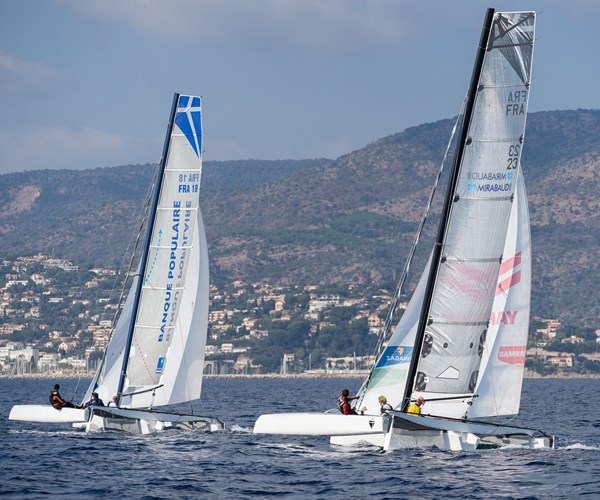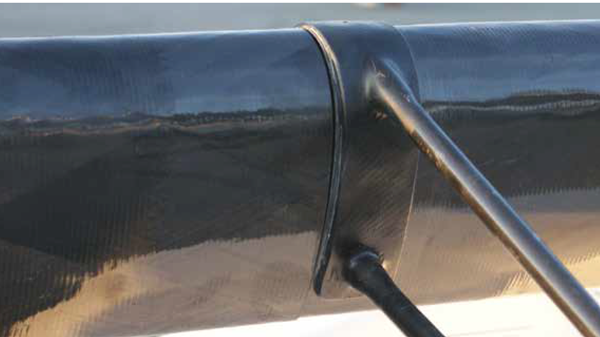Flexible cure prepreg finds use in marine and wind
It’s almost time for the 2018 Tour de France — no, not that one with the bicycles, but the Tour de France à la Voile. Hexcel (Stamford, CT, US) composite materials have been used for the race’s trimaran the DIAM 24’s mast construction from the outset.

DIAM 24 trimarans race in the Tour de France a la Voile event.
It’s almost time for the 2018 Tour de France — no, not that one with the bicycles, but the Tour de France à la Voile. It’s a coastal sailing race, where competitors sail small trimarans from port to port along the coast of France, from Dunkerque to Nice. It begins on July 6 and ends July 22.
It’s a one-design regatta, meaning that all sailors have the same boat and sails. While it has been in existence since 1978, the race adopted a new boat design three years ago, called the DIAM 24. The boat is designed by VPLP (Paris and Vannes, France), a well-known naval architectural firm founded by Marc Van Peteghem and Vincent Lauriot-Prévos (here’s a link to a recent CW story involving VPLP: /news/multiplast-group-carboman-produces-foils-for-beneteau ). The DIAM 24 is built by boatbuilder ADH Inotec (Port La Foret, France), and is reportedly easy to rig and launch. More than 90 boats have been built to date, sailing and racing on many waterways around the world, in France, Switzerland, the United Kingdom, the Bahamas, New Zealand and the US. The hulls are glass fiber over PVC foam core, infused with polyester resin, with carbon fiber strategically used for reinforcement where needed. The beams, which join the three hulls, are made with same way, but using an epoxy resin.

A closeup photo of the DIAM 24’s mast
Hexcel (Stamford, CT, US) composite materials, supplied by Groupe Gazechim Composites Distribution (Béziers, France), have been used for the DIAM 24’s mast construction from the outset. The masts, which are uncored, monolithic laminates, are constructed from Hexcel’s trademarked HexPly M79 prepreg, which offers a flexible cure cycle so production times can be optimized to the builder’s specific needs. The laminate consists of longitudinal plies of unidirectional prepreg to achieve weight and stiffness targets, with an M79 twill fabric prepreg ply used as the outer ply for a good surface finish and impact resistance. Masts rotate around a metallic ball swivel fitting (see photo below).

The mast is hand layed and cured in female tools, and is made in two sections that allow it to be disassembled to facilitate transportation on a boat trailer. Says Vianney Ancellin, ADH Inotec’s CEO, “The HexPly M79 prepreg system enables us to optimize our production efficiencies and still achieve the mechanical performance required for such a critical part. We are assured of consistently high-quality materials from Hexcel, and we appreciate the reliable and flexible supply and service we receive from Gazechim Composites Distribution.”
HexPly M79 is also used in the wind energy sector for composite wind turbine blades and was specifically developed for the manufacture of very thick laminate sections with reduced exotherm. It can be used in combination with unidirectional fibers as well as multiaxial fabrics. Manufacturers have a choice of cure cycles, and in contrast with traditional prepreg systems, which typically require a 10-hour cure cycle at 80°C, HexPly M79 prepreg can be cured at a lower temperature of 70°C for 8 hours, or can be processed with a more rapid cure cycle of just 4 hours at 80°C. Cure cycle reduction is key to accelerating blade manufacture throughput; as the cycle times reduce, the cost of blade production is also significantly reduced, says Hexcel. More information about M79 prepregs is available in this brochure: .
Related Content
Infinite Composites: Type V tanks for space, hydrogen, automotive and more
After a decade of proving its linerless, weight-saving composite tanks with NASA and more than 30 aerospace companies, this CryoSphere pioneer is scaling for growth in commercial space and sustainable transportation on Earth.
Read MoreThe potential for thermoplastic composite nacelles
Collins Aerospace draws on global team, decades of experience to demonstrate large, curved AFP and welded structures for the next generation of aircraft.
Read MoreBladder-assisted compression molding derivative produces complex, autoclave-quality automotive parts
HP Composites’ AirPower technology enables high-rate CFRP roof production with 50% energy savings for the Maserati MC20.
Read MoreLow-cost, efficient CFRP anisogrid lattice structures
CIRA uses patented parallel winding, dry fiber, silicone tooling and resin infusion to cut labor for lightweight, heavily loaded space applications.
Read MoreRead Next
Ceramic matrix composites: Faster, cheaper, higher temperature
New players proliferate, increasing CMC materials and manufacturing capacity, novel processes and automation to meet demand for higher part volumes and performance.
Read MoreScaling up, optimizing the flax fiber composite camper
Greenlander’s Sherpa RV cab, which is largely constructed from flax fiber/bio-epoxy sandwich panels, nears commercial production readiness and next-generation scale-up.
Read MoreCutting 100 pounds, certification time for the X-59 nose cone
Swift Engineering used HyperX software to remove 100 pounds from 38-foot graphite/epoxy cored nose cone for X-59 supersonic aircraft.
Read More












